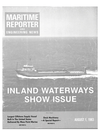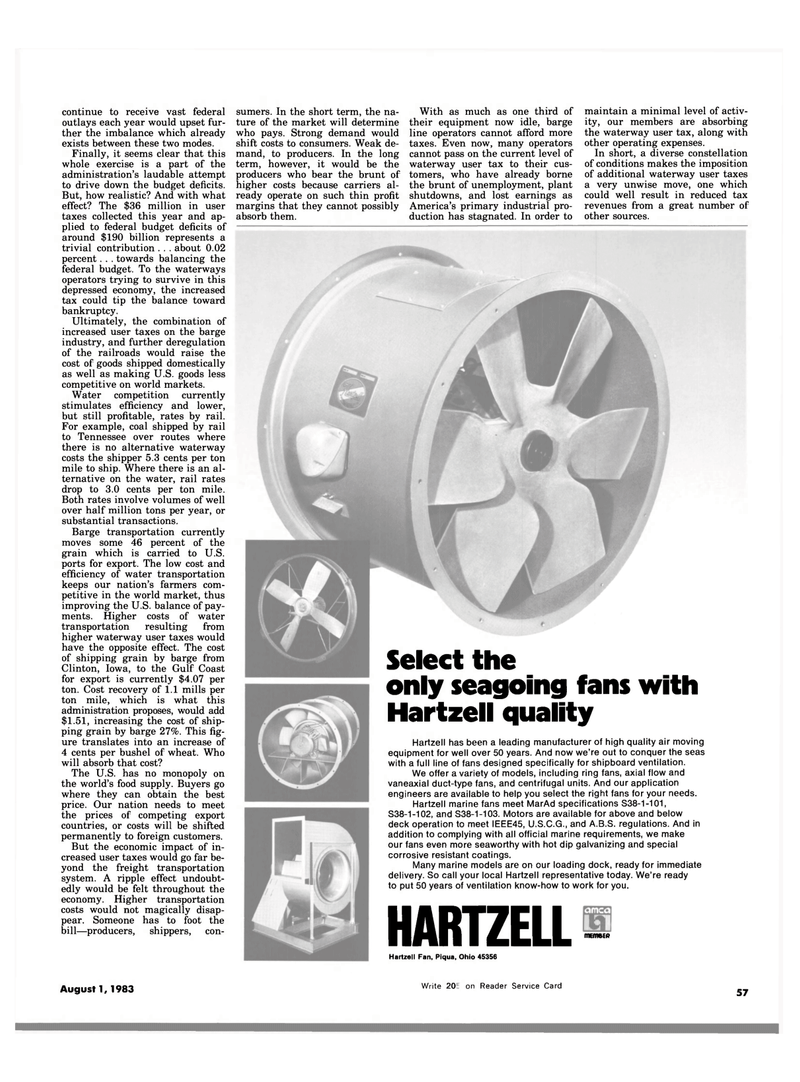
Page 57: of Maritime Reporter Magazine (August 1983)
Read this page in Pdf, Flash or Html5 edition of August 1983 Maritime Reporter Magazine
continue to receive vast federal outlays each year would upset fur- ther the imbalance which already exists between these two modes.
Finally, it seems clear that this whole exercise is a part of the administration's laudable attempt to drive down the budget deficits.
But, how realistic? And with what effect? The $36 million in user taxes collected this year and ap- plied to federal budget deficits of around $190 billion represents a trivial contribution . . . about 0.02 percent. . . towards balancing the federal budget. To the waterways operators trying to survive in this depressed economy, the increased tax could tip the balance toward bankruptcy.
Ultimately, the combination of increased user taxes on the barge industry, and further deregulation of the railroads would raise the cost of goods shipped domestically as well as making U.S. goods less competitive on world markets.
Water competition currently stimulates efficiency and lower, but still profitable, rates by rail.
For example, coal shipped by rail to Tennessee over routes where there is no alternative waterway costs the shipper 5.3 cents per ton mile to ship. Where there is an al- ternative on the water, rail rates drop to 3.0 cents per ton mile.
Both rates involve volumes of well over half million tons per year, or substantial transactions.
Barge transportation currently moves some 46 percent of the grain which is carried to U.S. ports for export. The low cost and efficiency of water transportation keeps our nation's farmers com- petitive in the world market, thus improving the U.S. balance of pay- ments. Higher costs of water transportation resulting from higher waterway user taxes would have the opposite effect. The cost of shipping grain by barge from
Clinton, Iowa, to the Gulf Coast for export is currently $4.07 per ton. Cost recovery of 1.1 mills per ton mile, which is what this administration proposes, would add $1.51, increasing the cost of ship- ping grain by barge 27%. This fig- ure translates into an increase of 4 cents per bushel of wheat. Who will absorb that cost?
The U.S. has no monopoly on the world's food supply. Buyers go where they can obtain the best price. Our nation needs to meet the prices of competing export countries, or costs will be shifted permanently to foreign customers.
But the economic impact of in- creased user taxes would go far be- yond the freight transportation system. A ripple effect undoubt- edly would be felt throughout the economy. Higher transportation costs would not magically disap- pear. Someone has to foot the bill—producers, shippers, con- sumers. In the short term, the na- ture of the market will determine who pays. Strong demand would shift costs to consumers. Weak de- mand, to producers. In the long term, however, it would be the producers who bear the brunt of higher costs because carriers al- ready operate on such thin profit margins that they cannot possibly absorb them.
With as much as one third of their equipment now idle, barge line operators cannot afford more taxes. Even now, many operators cannot pass on the current level of waterway user tax to their cus- tomers, who have already borne the brunt of unemployment, plant shutdowns, and lost earnings as
America's primary industrial pro- duction has stagnated. In order to maintain a minimal level of activ- ity, our members are absorbing the waterway user tax, along with other operating expenses.
In short, a diverse constellation of conditions makes the imposition of additional waterway user taxes a very unwise move, one which could well result in reduced tax revenues from a great number of other sources.
Select the only seagoing fans with
Hartzell quality
Hartzell has been a leading manufacturer of high quality air moving equipment for well over 50 years. And now we're out to conquer the seas with a full line of fans designed specifically for shipboard ventilation.
We offer a variety of models, including ring fans, axial flow and vaneaxial duct-type fans, and centrifugal units. And our application engineers are available to help you select the right fans for your needs.
Hartzell marine fans meet MarAd specifications S38-1-101,
S38-1-102, and S38-1-103. Motors are available for above and below deck operation to meet IEEE45, U.S.C.G., and A.B.S. regulations. And in addition to complying with all official marine requirements, we make our fans even more seaworthy with hot dip galvanizing and special corrosive resistant coatings.
Many marine models are on our loading dock, ready for immediate delivery. So call your local Hartzell representative today. We're ready to put 50 years of ventilation know-how to work for you.
HARTZELL
Hartzell Fan, Plqua, Ohio 45356 nwnsER
August 1, 1983 Write 206 on Reader Service Card 57 57

 56
56

 58
58
